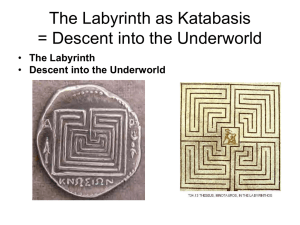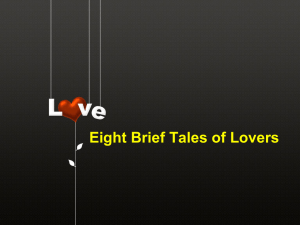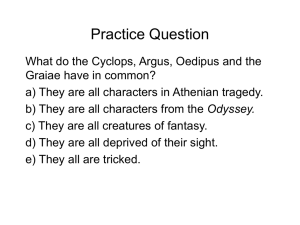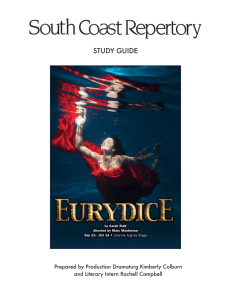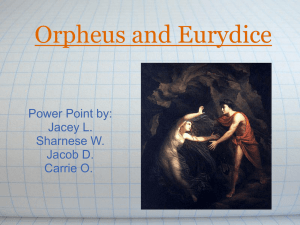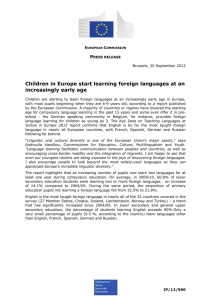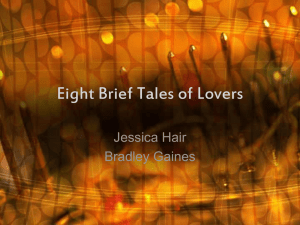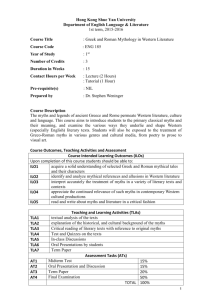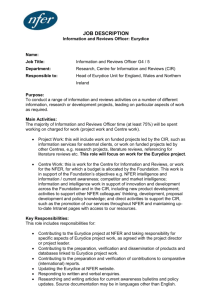Study Guide - A Noise Within
advertisement
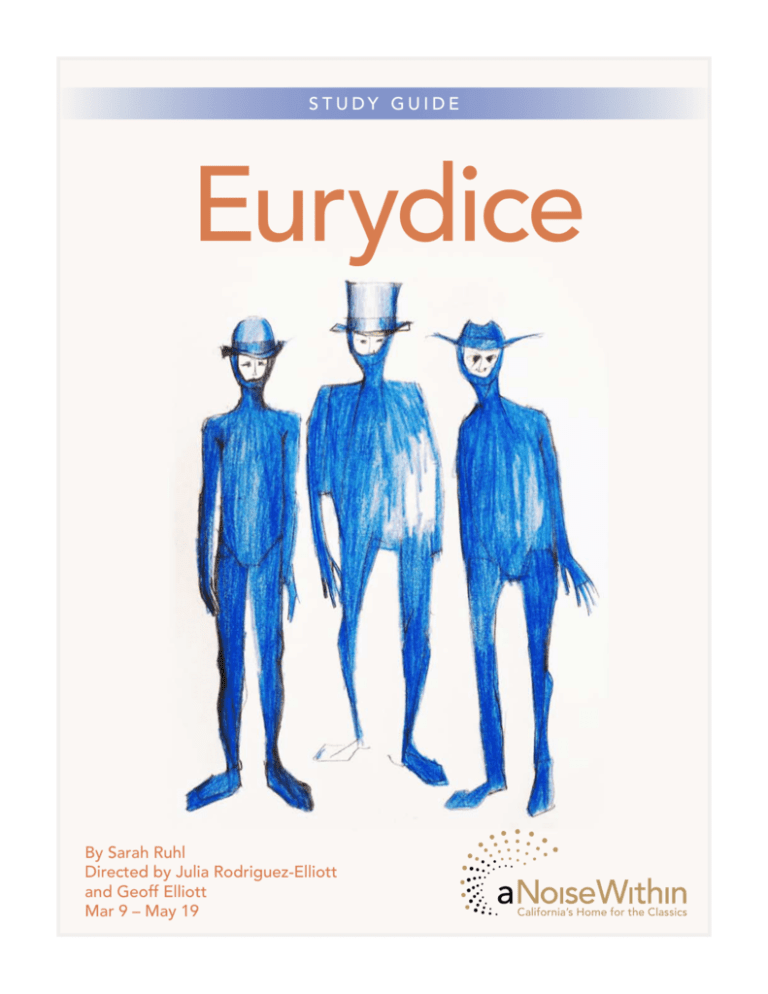
S tu dy Guide Eurydice California’s Home for the Classics By Sarah Ruhl Directed by Julia Rodriguez-Elliott and Geoff Elliott Mar 9 – May 19 California’s Home for the Classics Eurydice Study Guide Table of Contents 3 Eurydice: Characters 4 About the Play: Synopsis 5 Sarah Ruhl: Biography 6 Orpheus and Eurydice: A Brief Synopsis of the Myth 7Themes: A Poet’s Prose Influences Playwright Sarah Ruhl 9 Motifs in the Play 11 Questions for Discussion 13 Eurydice: Resource Guide 23 About Theatre Arts 24 About A Noise Within A NOISE WITHIN’S EDUCATION PROGRAMS MADE POSSIBLE IN PART BY: The Ahmanson Foundation, Alliance for the Advancement of Arts & Education, The Ann Peppers Foundation, Anonymous, The Capital Group Companies Charitable Foundation, Employees Community Fund of Boeing California, Judith A. Fong, The Green Foundation, Terry & Jeanie Kay, The Kiwanis Club of Glendale, John K. & Barbara Lawrence, Los Angeles County Arts Commission, Metropolitan Associates, Terri Murray, National Endowment for the Arts: Shakespeare for a New Generation, The Kenneth T. & Eileen L. Norris Foundation, City of Pasadena Department of Cultural Affairs, Elizabeth Redmond, Robert & Ann Ronus, The Rose Hills Foundation, Rotary Club of Pasadena, The Shubert Foundation, The Steinmetz Foundation, James & Trevessa Terrile, Tournament of Roses Foundation, Wells Fargo Foundation, WWW Foundation 2 A Noise Within 2012/13 Repertory Season Eurydice: Characters Eurydice Orpheus A beautiful, intelligent young woman; in love with Orpheus. A charming, gifted musician; in love with Eurydice. The Lord of the Underworld A Nasty Interesting Man A pesky but powerful child, played by the same actor as A Nasty Interesting Man. His name says it all… Her Father Eurydice’s father; already dead and resides in the Underworld; adores Eurydice. Big Stone A Chorus of Stones Impassive and cold; this trio resides in the Underworld with the deceased. Loud Stone Little Stone 3 A Noise Within 2012/13 Repertory Season About the Play: Synopsis Orpheus and Eurydice, a young couple, profess their love to each other. Orpheus tries to teach Eurydice a melody from a song he wrote for her, but Eurydice cannot feel the rhythm. She prefers reading to music. However, she promises to always remember the melody. Orpheus ties a string around her fourth finger so that she will never forget his love. Eurydice’s Father, who is dead, reads a letter full of advice for his daughter. He tells her that he is one of the few people in the underworld who still remember how to read and write. He drops the letter in a mail slot and imagines his daughter’s wedding day. After wandering away from her wedding party, Eurydice stands before a water pump and wishes there were more interesting guests. The Nasty Interesting Man appears and invites her to a party with more interesting people, but Eurydice declines. However, he returns again and entices her with a letter from her father, which he claims got delivered to his address by mistake. Reluctantly, Eurydice follows the man into his apartment. The man professes his love to Eurydice. She steals the letter from him and runs towards the stairs. She trips, falls down a flight of six hundred stairs, and dies. At the entrance of the underworld, a chorus of stones announces Eurydice’s arrival. Carrying an umbrella and a suitcase, Eurydice is bewildered and transitions from speaking the language of the living to the language of dead people, the language of stones. She imagines taking a trip by train. Eurydice’s father meets her. She does not recognize him. He pretends to be the porter of the train and builds her a room made of string and invites her in. In the land of the living, Orpheus writes letters and music to Eurydice. Eurydice receives the letters and a book but does not know how to read them. Eurydice’s Father reads her Orpheus’ letters and teaches her what the words are. She and her father share stories and memories. 4 A Noise Within 2012/13 Repertory Season When they start to remember music by singing, the stones become disturbed. They command Eurydice’s father to stop singing and go back to work. While Eurydice is alone, a child, the Lord of the Underworld, comes by on his tricycle. He checks to see if Eurydice is comfortable and informs her that rooms and fathers are not allowed in the underworld. He threatens to dip her in the river again. Eurydice tells her father about her memories of Orpheus. Meanwhile, Orpheus devises a plan to get to the underworld by singing. He writes her a letter which she receives and can read. Orpheus sings his way to the gates of hell and knocks. The Lord of the Underworld, still a child, greets Orpheus. Orpheus asks what he must do to have Eurydice go with him. The Lord of the Underworld tells him to start walking home without looking back under any circumstances. Eurydice hears her husband at the gate and wants to go with him, but is concerned to leave her father behind. Her father reassures her and urges her to go with Orpheus. He leaves her with one final piece of advice — Orpheus cannot turn around to see her, so she must not make any sound. She is afraid and uncertain but she follows behind Orpheus. They walk for awhile, but then Eurydice decides to catch up to Orpheus. She calls Orpheus’ name questioningly and he looks back, breaking the terms of the contract. Eurydice returns to the underworld, only to find that her string room has been dismantled and her Father has dipped himself in the river of forgetfulness. The Lord of the Underworld, now grown, and tells Eurydice he has chosen her as his bride. She asks for a moment to prepare herself and writes a letter to Orpheus, places it on the ground, and dips herself in the river. Orpheus arrives in the underworld, recognizes Eurydice, and goes to her. It rains on him and he forgets. He finds her letter but cannot read it. ❖ About the Playwright: Sarah Ruhl List of Works 2001 • Melancholy Play 2001 • Lady With the Lap Dog • Anna Around the Neck 2002 • Virtual Meditations #1 2003 • Passion Play 2003 • Eurydice 2003 • Late: a cowboy song 2004 • The Clean House 2006 • Demeter in the City 2007 • Dead Man’s Cell Phone 2009 • In the Next Room or the vibrator play 2010 • Orlando 2011 • Stage Kiss • Three Sisters (adapted from Chekhov) 5 A Noise Within 2012/13 Repertory Season Though Sarah Ruhl originally intended to be a poet, she fell in love with playwriting after studying with playwright Paula Vogel at Brown University. Under Vogel, she wrote her first play, The Dog Play. After graduating in 1997, she did graduate work at Pembroke College in Oxford, England and later earned a Master of Fine Arts from Brown. She won the Helen Merrill award and the Whiting Writers’ Award in 2003. She first gained widespread praise for her play The Clean House, a play about finding happiness in spite of death. In 2004, it won the Susan Smith Blackburn Prize and was a Pulitzer Prize finalist in 2005. Her play Eurydice is inspired by her father, who died in 1994 of cancer. In 2006, she received the MacArthur Fellowship for her work in the arts. In 2008, in New York City at Playwrights Horizons, her play Dead Man’s Cell Phone premiered, receiving enthusiastic praise. Many of her plays mix the mundane with the mythical and supernatural, exploring the delicate line between life and death. Ruhl is known for her retellings and adaptations of classic stories and for bringing a clear feminist voice to the contemporary stage. Her work has been highly recognized and produced at many important theaters in America and abroad. ❖ From “Love, Death and Whimsy in the Aesthetic of Sarah RuhL” By Erin Neel In a 2009 interview with Gwen Orel of the esteemed Writer magazine, Sarah Ruhl characterizes her oeuvre as such: “‘They’re all about love and death’” (“How I Write: Sarah Ruhl”). Such a statement is at once paradoxically concise and exhaustive: reductionist though it is, Ruhl’s aesthetic is straightforwardly encompassed by her offhand, if not self-aware, response. What enabled this playwright— not yet 40 years of age—to garner two Pulitzer Prize nominations for Drama within a five-year span (in 2005 for The Clean House and in 2010 for In the Next Room, or the vibrator play), however, is her specific brand of theatricality, one rife with a whimsy that elicits belly laughs moments before catapulting the audience member or reader into stinging, unwitting despair. In anachronistic postmodern fashion, Ruhl looks to the past, appropriating myths and theatrical genres to reinvent them in the present, and in so doing, demonstrates the hallmarks of her writing, namely an economy of poetic language reflected in both dialogue and stage directions alike; a utilization of tableaux and scripted imagery; and extremity of emotional juxtaposition. A two-time graduate of Brown University where she received her BA in English and her MFA in Playwriting, Ruhl became a MacArthur Fellow in 2006. The Pulitzer Prize-winning playwright Paula Vogel served as her thesis adviser and mentor while Ruhl was at Brown and recalls being immediately struck by the burgeoning writer’s ability to move her reader: charged with writing a play featuring a central character of a dog, Ruhl detailed the dog’s realization that its master had passed away and was not to return home, employing Japanese Kabuki stage techniques in the realization of the story. Not only would the incorporation of theatrical device mark a decisive feature of Ruhl’s aesthetic but Vogel’s emotional reaction to the piece — to her partner, Anne Fausto-Sterling, Vogel read the work aloud to her partner and upon conclusion, “both women were weeping” — illustrates the oft-echoed degree to which reader and audience members alike 6 A Noise Within 2012/13 Repertory Season continue to be moved by Ruhl’s work, the title of the article, “Playwright Laureate of Grief,”from which such an anecdote originates quite blatantly speaking to this tendency. Journalists are wont to take a stab at encapsulating Ruhl, the aforementioned article demonstrating such an attempt: “Ruhl’s plays are a combination of the avant-garde, Greek myth, lyrical poetry, and magical realism, with a smattering of vaudeville and German expressionism thrown in. It’s a blend that could easily give way to postmodern obscurantism, except that Ruhl has a big heart.” While quirky and gleefully deviating from realism, Ruhl’s celebration of the nonsensical does not constitute nonsense: the audience is rewarded for its willing suspension of disbelief by the revelation of recognizable emotion even in the most unrecognizable of circumstances (“the plays feature characters who turn into almonds, elevators in which it rains, plots that eschew the linear, and jokes told in Portuguese”) (Goodman “Playwright Laureate of Grief”). through a distinctly feminine lens. By redefining the subject, Ruhl contributes to a tradition of what Miriam Chirico coined “‘mythic revisionary drama,’” which is connected to the cultural and historical function of myth: “Part of the process of transmitting a myth from one generation to the next is to offer corrections or make adjustments to the story, and in this way mythic revision acts as a critical as well as creative apparatus opening up new meanings behind each myth” (1516). Chirico writes that Ruhl exhibits other precepts of “mythic revisionary drama” that further speak to the feminist leanings of her work, such as a “shift in focus [that] involves transmotivation as well: Eurydice, torn between loving her father and returning to her new husband, instigates her own forced return to the Underworld as she calls out to Orpheus and prompts him to turn back to her” (15, 25). Will Eurydice choose to stay in the Underworld with her father, …or opt to follow her husband back to the land of the living? Though the grace by which Ruhl navigates fluidly from moment to moment plunges the viewer or reader into the world of the play, this distinctly anti-Aristotelian aesthetic, a benchmark of feminist theatrical theory, allows for an abundance of theatrical coups, from snowfall onstage (in The Clean House) to the aforementioned raining elevator (in Eurydice). In situating Ruhl within the contemporary pantheon of feminist playwrights, AlShamma cites Elaine Aston’s introduction to Sue-Ellen Case’s 2008 reissued Feminism and Theatre, arriving at the following: “In the view of some feminist theater critics, the single Aristotelian climax is associated with masculinity and male sexuality; Ruhl’s dramaturgy may be considered feminist to the extent that it resists this model. Ruhl thus conforms to current trends in women’s playwriting without, however, being conformist” (11). Within a multitude of feminist theatrical practices, three main tendencies are foreground in the work of Sarah Ruhl, explicitly her continuous reliance upon female protagonists and the consequent bid to bring women“‘centre stage’” and thus “‘construct themselves as the subject rather than as the object of performance’”; her anti-Aristotelian, episodic dramaturgy; and her emotional point of departure (Aston et al 5; Carlson 532). In regards to the first characterization and by means of her feminist transfocalization of the Orpheus myth does Eurydice epitomize the feminist practice of recasting history 7 A Noise Within 2012/13 Repertory Season “Transmotivation” is defined by Chirico as being “the creative process of revising the character’s reasoning to correspond to his or her new actions,” in this case used as a means of endowing Eurydice with an agency in this myth of which she was hitherto not in possession (20). It is scripted that Eurydice calls out Orpheus’ name whereupon he turns around and “the worlds fall away,” instigating the final few moments of their time together before she descends anew, thereby implicating Eurydice in the question of culpability, one ambiguous enough to allow the given artistic team of each and every production to decide upon the interpretation thereof (Ruhl, Eurydice 397). Chirico also cites a certain Brechtian employment of “ostranenie, the familiar made strange,” in the example of the “anachronistic” raining elevator that serves as the “symbol of the River Lethe”: in addition to serving as an example of the theatrical spectacular and spectacle in Ruhl’s work, this “ostranenie” helps to remind the reader and audience that they are beholding a very specific reinterpretation of this myth and incites questions regarding potential significance or meaning (25). In this case, the means by which the River Lethe is represented is not as significant as the fact that it is now used as a device to create the central conflict of the story: Will Eurydice choose to stay in the Underworld with her father, who she slowly comes to remember during her time there, or opt to follow her husband back to the land of the living? As Chirico states, the myth is expanded “pragmatically, stretching the narrative to include the space of the Underworld where Eurydice and her father meet and converse” and within this space we also behold the chorus of Stones, a “dramaturgical adoption,” meaning the incorporation of “devices” such as “choral speaking” from classical Greek drama “to convey the transcendental aspect of the myth” (20, 25). The Stones speak a language tantamount to silence, thus Eurydice has to relearn English from her father. By means of the various markers that remind the audience and reader of the mythic aspect of this story, Ruhl undertakes a “reenvisioning of Eurydice no longer as the object of Orpheus’ romantic love but as autonomous woman [in which Ruhl] implies that she is unable to meld her life with Orpheus,’” and Chirico thus concludes that “Ruhl has recast the myth to show a woman divided between two strong loyalties: her love of her husband versus her love for her father” (27). Language becomes a powerful theme and tool, the means by which she reconnects with her father and the letters written by both he and Orpheus symbolic of the memory aspect of the play. They are reminders of love and to love: moments before the play ends, Eurydice writes a letter to Orpheus that begins with “To My Husband’s Next Wife,” detailing a list of perfectly inane and consequently excruciatingly intimate directives that only a wife would know (Ruhl, Eurydice 410). Eurydice may still be an object of desire—that of Orpheus’ romantic love and her father’s paternal—but Ruhl ultimately imbues Eurydice with the decision of whose love will abide. Furthermore, Ruhl redefines the myth by means of irony insofar as the audience knows more than the characters: the tragedy of the myth is consequently located in the actor-spectator relationship. In a mere and final eleven pages of the play, Orpheus turns around and is separated from Eurydice anew, unbeknownst to her father who returns to the stage moments after to dip himself once more in the river to forget the anguish resulting from the departure of his daughter. Seconds after he does so and goes to sleep peacefully onstage, Eurydice returns to discover him, consigned once more to the Underworld. Unable to bear the dual loss of her husband and her father, she follows suit and dips herself in the river, thereafter succeeded by the final tableau of the play in which Orpheus steps out of the raining elevator—an extension of the same metaphorical river of forgetfulness—and beholds the sleeping Eurydice and her father. He knows not who they are. The juxtaposition of these moments as each character misses the other by seconds makes for a harrowing end to the play: now all are together in the Underworld but none of them can recognize one another. The characters, however, are insulated by their ignorance, the tragedy displaced for the audience to then bear its burden. 8 A Noise Within 2012/13 Repertory Season In addition to Ruhl’s subversion of the traditional structure of the Orpheus myth by maintaining Eurydice as object of the latter’s love but subject and protagonist of the narrative, this particular play also speaks to Reinshagen’s citation of emotion as a point of departure for the female storyteller. As myriad sources are quick to note, Ruhl composed Eurydice in the aftermath of her father’s death, henceforth imbuing it with the memory play aspect so intrinsic to its potent emotionality. States Ruhl in an interview, “The play is really dedicated to my father, who died when I was twenty and he was fifty-five…I wanted to write something where I would be allowed to have a few more conversations with him. A myth exploring the underworld and the connection between the dead and the living was a way to negotiate that terrain” (Weckwerth 29). Indeed, the theme of grief so explicit in Eurydice is a pervasive aspect of Ruhl’s dramaturgy, seemingly the impetus behind or subplot to nearly, if not all, of her canon. Works Cited: Al-Shamma, James. Sarah Ruhl: A Critical Study of the Plays. Jefferson: McFarland &, Co., 2011. EBL. Web. 24 Nov. 2012. Case, Sue-Ellen, and Elaine Aston. Feminism and Theatre. New York: Palgrave Macmillan, 2008. Print.Chirico, Miriam. “Hellenic Women Revisited: The Aesthetics of Mythic Revision in the Plays of Karen Hartman, Sarah Ruhl and Caridad Svich.” Dramatic Revisions of Myths, Fairy Tales and Legends: Essays on Recent Plays. By Verna A. Foster. Jefferson: McFarland & Company, Inc., 2012. 15-33. EBL. Web. 24 Nov. 2012. Orel, Gwen. “How I Write: Sarah Ruhl.” The Writer Aug. 2009: 66. Academic Search Elite. Web. 24 Nov. 2012.“Drama: Current Winners and Finalists.” The Pulitzer Prizes. N.p., n.d. Web. 28 Nov. 2012.Goodman, Lawrence. “Playwright Laureate of Grief.” Brown Alumni Magazine. Brown Alumni Magazine, 23 Mar. 2007. Web. 24 Nov. 2012. Ruhl, Sarah. Eurydice. The Clean House and Other Plays. New York: Theatre Communications Group, 2006. 325-418. Print.Weckwerth, Wendy. “More Invisible Terrains.” Theater 34.2 (2004): 28-35. Project Muse. Web.18 Apr. 2012. ❖ Erin Neel is a current Master of Arts student in theatre at California State University, Northridge. She received her Bachelor of Arts in theology and Spanish from Georgetown University. She has interned with La Jolla Playhouse and worked with several Los Angeles theatre companies including The Blank (as a stage manager for the Living Room Series); Theatricum Botanicum (as an assistant stage manager); and the illustrious A Noise Within, where she has happily worked in the box office since August of 2011. Orpheus and Eurydice: origins of the Myth Eurydice is in some versions an oak nymph (dryad) and in some versions a mortal woman. While dancing on her wedding day, or while being chased by either a satyr (half man, half goat) or by another man, Artistaeus, she is bitten by a poisonous snake and dies. Her spirit travels to the underworld, Hades. Hades refers to both the place and the Lord of the Underworld. Orpheus leading Eurydice from the Underworld by Jean-Baptiste-Camille Corot, 1861. The myth of Orpheus and Eurydice is over 2000 years old. What we know of the story comes from the Roman poets Virgil and Ovid, although Orpheus is mentioned in a two-word fragment on papyrus by the Greek poet Ibycus that dates to the 6th Century BCE. All that remains is “onomaklyton Orphen” (famous Orpheus). In some versions of the myth he is the son of the god Apollo or a Thracian king and the muse Calliope. In all versions, he is an exceptionally talented singer and musician. Orpheus appears in other stories as well; he was one of the Argonauts on board with Jason in the quest for the golden fleece. However he is best known for his tragic loss of Eurydice. Grief stricken, Orpheus uses all his powers of music to gain access to the Underworld and ask for Eurydice to come back with him alive. The Lord of the Underworld agrees on one condition: that on the journey out, Orpheus must not look back at Eurydice. At a critical moment, Orpheus looks back and Eurydice dies a second time. Orpheus returns to the outer world without Eurydice, but continues to play music. He never marries again. In some versions, he is attacked and torn apart limb from limb by a group of women called Maenads. In Ovid’s version, Orpheus’s spirit was reunited with Eurydice after death and they live happily ever after in the underworld. Sarah Ruhl ‘s play adapts the myth in a few key ways. She focuses on Eurydice’s journey, she invents the character of Eurydice’s father, and we see Eurydice make a decision to catch up to Orpheus and call his name on the way out of the underworld. In the end of the play, as Orpheus enters the underworld through the raining elevator, he does not recognize Eurydice and cannot read the letter she has left for him. ❖ The story in brief, using epic poetry excerpts: http://www.vcu.edu/engweb/webtexts/eurydice/eurydicemyth.html A modern vernacular re-telling: http://www.shmoop.com/orpheus-eurydice/summary.html Another brief narrative version: http://www.paleothea.com/Myths/Orpheus.html 9 A Noise Within 2012/13 Repertory Season Versions of the myth VIRGIL She, doomed girl, running headlong along the stream, so as to escape you, did not see the fierce snake, that kept to the riverbank, in the deep grass under her feet. But her crowd of Dryad friends filled the mountaintops with their cry… Orpheus, consoling love’s anguish, with his hollow lyre, sang of you, sweet wife, you, alone on the empty shore, of you as day neared, of you as day departed. He even entered the jaws of Taenarus, the high gates of Dis, and the grove dim with dark fear, and came to the spirits, and their dread king, and hearts that do not know how to soften at human prayer. The insubstantial shadows, and the phantoms of those without light, came from the lowest depths of Erebus, startled by his song… The House of the Dead itself was stupefied… And now, retracing his steps, he evaded all mischance, and Eurydice, regained, approached the upper air, he following behind (since Proserpine had ordained it), when a sudden madness seized the incautious lover, one to be forgiven, if the spirits knew how to forgive: he stopped, and forgetful, alas, on the edge of light, his will conquered, he looked back, now, at his Eurydice. In that instant, all his effort was wasted, and his pact with the cruel tyrant was broken, and three times a crash was heard by the waters of Avernus. ‘Orpheus,’ she cried, ‘what madness has destroyed my wretched self, and you? See, the cruel Fates recall me, and sleep hides my swimming eyes, Farewell, now: I am taken, wrapped round by vast night, stretching out to you, alas, hands no longer yours.’ She spoke, and suddenly fled, far from his eyes, like smoke vanishing in thin air, and never saw him more, though he grasped in vain at shadows, and longed to speak further: nor did Charon, the ferryman of Orcus, let him cross the barrier of that marsh again. What could he do? Where could he turn, twice robbed of his wife? With what tears could he move the spirits, with what voice move their powers? Excerpt from Georgics, BkIV:453-527 Orpheus and Eurydice by Virgil, translated by A.S. Kline, 2002. 1 0 A Noise Within 2012/13 Repertory Season OVID “While the newly wedded bride, Eurydice, was walking through the grass, with a crowd of naiads as her companions, she was killed, by a bite on her ankle, from a snake, sheltering there. When Thracian Orpheus, the poet of Rhodope, had mourned for her, greatly, in the upper world, he dared to go down to Styx, through the gate of Taenarus, also, to see if he might not move the dead. Through the weightless throng, and the ghosts that had received proper burial, he came to Persephone, and the lord of the shadows, he who rules the joyless kingdom. Then striking the lyre-strings to accompany his words, he sang: ‘O gods of this world, placed below the earth, to which all, who are created mortal, descend; if you allow me, and it is lawful, to set aside the fictions of idle tongues and speak the truth, I have not come here to see dark Tartarus, nor to bind Cerberus, Medusa’s child, with his three necks, and snaky hair. My wife is the cause of my journey. A viper she trod on diffused its venom into her body, and robbed her of her best years. I longed to be able to accept it, and I do not say I have not tried: Love won. He is a god well known in the world above, though I do not know if it is so here: though I do imagine him to be here, as well, and if the story of that rape in ancient times is not a lie, you also were wedded by Amor. I beg you, by these fearful places, by this immense abyss, and the silence of your vast realms, reverse Eurydice’s swift death. All things are destined to be yours, and though we delay a while, sooner or later we hasten home. Here we are all bound, this is our final abode, and you hold the longest reign over the human race. Eurydice, too, will be yours to command, when she has lived out her fair span of years, to maturity. I ask this benefit as a gift; but, if the fates refuse my wife this kindness, I am determined not to return: you can delight in both our deaths.’ 1 1 A Noise Within 2012/13 Repertory Season The bloodless spirits wept as he spoke, accompanying his words with the music. Tantalus did not reach for the everretreating water: Ixion’s wheel was stilled: the vultures did not pluck at Tityus’s liver: the Belides, the daughters of Danaüs, left their water jars: and you, Sisyphus, perched there, on your rock. Then they say, for the first time, the faces of the Furies were wet with tears, won over by his song: the king of the deep, and his royal bride, could not bear to refuse his prayer, and called for Eurydice. She was among the recent ghosts, and walked haltingly from her wound. The poet of Rhodope received her, and, at the same time, accepted this condition, that he must not turn his eyes behind him, until he emerged from the vale of Avernus, or the gift would be null and void. They took the upward path, through the still silence, steep and dark, shadowy with dense fog, drawing near to the threshold of the upper world. Afraid she was no longer there, and eager to see her, the lover turned his eyes. In an instant she dropped back, and he, unhappy man, stretching out his arms to hold her and be held, clutched at nothing but the receding air. Dying a second time, now, there was no complaint to her husband (what, then, could she complain of, except that she had been loved?). She spoke a last ‘farewell’ that, now, scarcely reached his ears, and turned again towards that same place. Stunned by the double loss of his wife, Orpheus was like that coward who saw Cerberus, the three-headed dog, chained by the central neck, and whose fear vanished with his nature, as stone transformed his body…” From Metamorphoses, Book X by Ovid, Translation by A.S. Kline, 2000. SHAKESPEARE RILKE “For Orpheus’ lute was strung with poets’ sinews, Whose golden touch could soften steel and stones, Make tigers tame, and huge leviathans Forsake unsounded deeps to dance on sands.” “A woman so loved that from one lyre there came more lament than from all lamenting women;that a whole world of lament arose, in which all nature reappeared: forest and valley,road and village, field and stream and animal;and that around this lament-world, even as around the other earth, a sun revolved and a silent starfilled heaven, a lament-heaven, with its own, disfigured stars —:So greatly was she loved. Shakespeare, (1590s)The Two Gentlemen of Verona (Act III Scene ii) But now she walked beside the graceful god,her steps constricted by the trailing graveclothes, uncertain, gentle, and without impatience.She was deep within herself, like a woman heavy with child, and did not see the man in front or the path ascending steeply into life.Deep within herself. Being dead filled her beyond fulfillment. Like a fruit suffused with its own mystery and sweetness,she was filled with her vast death, which was so new, she could not understand that it had happened.” From Orpheus. Eurydice. Hermes. 1904, By Rainer Maria Rilke, translated by Stephen Mitchell, 1982 1 2 A Noise Within 2012/13 Repertory Season Themes of the play Water Strings Water is a main theme of the play and appears literally onstage in the raining elevator. In Greek Mythology, the entrance to the underworld was surrounded by a series of five rivers. Each river had a name and specific purpose: Styx (the river of Hate) Akheron (the river of pain), Pyriphlegethon (the river of fire) Kokytos (the river of wailing), and Lethe (the river of forgetfulness). In the play, both Lord of the Underworld and the Stones refer to the dead characters as having been “dipped” in a river which makes the dead characters forget their lives. In the play the river is unnamed, but Eurydice’s father advises her to hold her breath the next time she is dipped so she doesn’t forget. Orpheus ties a string around Eurydice’s finger and Eurydice’s father builds her a room out of string onstage. In Ancient Roman and Greek Mythology, the Fates or Moirae were three female goddesses that supervised human life. The life of each individual was a string that would be spun into string (birth), measured (life), and then cut (death). This concept uses a metaphor from spinning, a task that women in Ancient Greece and Rome fulfilled. We have certain expressions about family and love that still use string imagery for example: the ties that bind, family ties, heart strings, tying the knot, twist of fate, etc. Music Mythically, Orpheus is known as the most talented and famous musician of Ancient Greece. He played the lyre, a stringed instrument that is a precursor to lutes, violins, and guitars. He uses his music to enter the underworld alive. The idea that music has magical or shamanic powers is an ancient one. After Orpheus returned to the world without Eurydice, he continued playing music and singing. In some versions of the myth, he is torn apart by a group of women called Maenads or Bacchae, but even after his head is cut off, it still sings. The Chorus The Chorus of Stones in Eurydice fulfills a role similar to most ancient Greek plays. They comment on the action, the character’s decisions, and collectively represent one perspective. Choruses tend to represent the general population of the story and can serve as guides for the audience and speak both to the characters and the audience directly. Chorus members may speak, sing, dance or move together in unison. They can reveal information about the characters to the audience. Ancient Greek choruses originally contained as many as 50 singers and dancers. The number reduced over time to groups of 12 and 15 for tragedies and 24 for comedies. In Eurydice, the chorus is not made up of humans, but of three stones. How does this affect the relationship of the chorus to the characters and the audience? 1 3 A Noise Within 2012/13 Repertory Season Orpheus is known for playing the lyre, a five-stringed instrument. Like any stringed instrument, the vibrating strings produce sound when plucked or bowed. When Orpheus writes Eurydice a letter and explains his thoughts of how he can enter the underworld on the pitch of a raindrop, he is nearly talking about concepts of String Theory. String Theory, also known as the “Theory of Everything” is a theory in physics that attempts to unify how gravity and quantum mechanics fit together. One of its features is that the universe is made up of vibrating filaments or “strings” of energy. ❖ Scenic Design: Jeanine A. Ringer Approaching a play like Eurydice is like trying to decipher a dream that you’ve just woken up from. It’s a familiar story written in a very poetic way. For me the main challenge in designing the set was creating a nebulous world that spans the bridge between the land of the living and the underworld. A key element in the script is water. We’ve really tried to create a world that is permeated by this force; completely shrouded in blue with a sense of both sky and water. Water in the show quenches thirst, brings souls to the underworld, replenishes life and extinguishes memories. It is the most powerful element in our world and the next. We’ve really tried to simplify the world down to its purest form in order to let Sarah Ruhl’s lyrical script really be heard. ❖ 1 4 A Noise Within 2012/13 Repertory Season Ms. Ringer has spent the last decade working in television, film, theater and other live events. With A Noise Within: A Christmas Carol and Eurydice. She received her MFA from the University of California, Irvine. There, she took a particular interest in immersive theater, where the scenic environment completely surrounds the audience, and provides the spectator with an opportunity to interact with the production. From there, she went on to work in film and television both as a Production Designer and as a Stylist/Dresser. She has since had opportunities to work on multiple theatrical productions, films, commercials, music videos, and live events. www.jnicholasdesigns.com Sound Design: Doug Newell While reading Eurydice I was struck by the literal and thematic use of water throughout the play. My thoughts continually drifted to images of dropping water and the ripple effect created by the impact of a drop on a static body of water. As I learned in physics, gravity acts as a force on water ripples, decreasing their size as they move away from the source of impact in an attempt to return the body of water back to its equilibrium level. So too in audio sound waves will dissipate as they moves from their source because of reflection, refraction and attenuation until nothing of the sound waves remain. When I met with Geoff to discuss the play he mentioned the dialogue being like “resonant poems.” The power of the dialogue not being in the literal interpretation of the words but in their ability to evoke images, memories and emotions. As a sound person when a word like “resonance” is used my ears perk up because of its direct relation to the field of audio. 1 6 A Noise Within 2012/13 Repertory Season In sound terms, resonance refers to the sympathetic vibration of an object at a particular frequency caused by a source object’s sound wave. For instance, if a tuning fork that has been struck is brought near a second one tuned at the same frequency, the second tuning fork will receive enough stimulus that it too will begin to vibrate. As humans, resonance is important in our ability to hear. Our ear canals are formed in a way so that their resonant structure makes them particularly sensitive to the frequencies of speech. As I work on building sound cues for the show I’ll continually refer to the images of rippling water and the idea of one objects resonance with another. My attempt will be to abstract sounds rather than present accurate representations, to use reverberations and echoes rather than the sounds that create them. Conceptually I’ll try to focus on effect and not cause. Like The Stones say in the play: “The station is like a train but there is no train.” “The train has wheels that are not wheels.”“There is the opposite of a wheel and the opposite of smoke and the opposite of a train.” ❖ DOUG NEWELL (Sound Design) With ANW: original music & sound design for The Doctor’s Dilemma, original music & sound design for The Illusion, original music & sound design for Blithe Spirit, sound design for Twelfth Night, original music for Great Expectations, original music & sound design for Measure For Measure. Other theatres: sound design for A Snow White Christmas Pasadena Playhouse, original music & sound design for The Heiress Pasadena Playhouse, sound design for The Boomerang Effect Odyssey Theatre, original music & sound design for No Good Deed ITF/Furious Theatre Company, original music & sound design for boom Furious Theatre Company, original music and sound design for The Pain & the Itch The Theatre @ Boston Court/Furious Theatre Company, sound design for Girls Talk Lee Strasberg Theatre. Film/ TV: production sound & sound design for Comrades Landed Entertainment, production sound for The Walking Dead Webisodes AMCtv/GenerateLA, sound designer for Revenge of the Bimbot Zombie Killers Celtino Productions, re-recording mixer for Takedowns & Falls Resilient Pictures, composer & sound designer for Pure Shock Value Furious Films. Education & Training: BA in theatre Arts, Texas A&M University. Doug is the owner and operator of Zipline sound (www. ziplinesound.com) About the Production: Original Score by Endre Balogh Having worked with several other ANW productions, my musical process is very involved with the actual rehearsals. In past shows, I have been an integral part of the staging — as a costumed character moving in and out of the action. In Eurydice, that may be somewhat different (Geoff and I will be working on that aspect as his direction evolves) so I may be a more offstage entity this time. Nevertheless, I plan on being at most of the rehearsals that will involve music cues so that I can invent what is necessary on the spot to fit the tone of what will be said and done by the actors. For instance, for any particular musical cue, I already know where in the script they will go and now it is a matter of observing what the actors are doing and getting a sense of exactly what music will be needed — either to underscore the action or to create transition music between scenes. At the rehearsals I will try out different musical possibilities until Geoff and I agree on something right. Then I’ll cite that down and further refine it when I take it back home. In that way, the process of coming up with music is very much a collaborative venture and is also organically tied to the creative process that Geoff and the actors are doing. By immersing myself in rehearsals, small bits of thematic material will suggest themselves. Over time, those musical experiments evolve into my permanent collection of little leitmotifs — musical themes that reoccur, which I associate with particular characters or situations. I actually write down very little of this music, other than the few bars I need to remind myself where to start. Just like the actors, I need a cue to begin playing and also need to know what action or line cues me to stop. This allows me to improvise the rest of the music anew at each performance. Consequently, the music at each show will always be a little different. Doing it this way allows me a lot of creative freedom. It keeps the music fresh and also frees me to tailor the length of music required to fit the many timing variables that can happen during a live performance. 1 7 A Noise Within 2012/13 Repertory Season ENDRE BALOGH (Violinist/Composer) collaborated with ANW to write and perform incidental music for several productions including Oliver Twist, The Winter’s Tale, and Desire Under the Elms, sometimes even performing live as a costumed character on stage. With an impressive list of international concert triumphs to his credit, violinist Endre Balogh has performed as soloist with the Berlin Philharmonic, Rotterdam Philharmonic, Zürich Tonhalle Orchestra, Frankfurt Symphony, and Basel Symphony as well as several other European ensembles. In the United States he has appeared with the Los Angeles Philharmonic and the orchestras of Washington D.C., Seattle, Denver, Dallas, and Honolulu to name just a few. In the course of his career he has worked with such eminent conductors as Zubin Mehta, Edo de Waart, James de Priest, Lawrence Foster, Milton Katims, and Christoph von Dohnányi. He was the youngest First Prize winner in the history of the prestigious Merriweather Post Competition. Endre has had several concert tours of the United States, and Europe; which have included live televised recitals in Amsterdam and taped performances for the BBC. He is an accomplished Chamber Music performer and toured throughout the United States, Canada, and Europe with the Pacific Trio for nearly 30 years. He has also played with such luminaries as Vladimir Horowitz and Leonard Pennario as well as in the acclaimed series of 1993 chamber concerts: “André Watts and Friends.” Until his passing in 2010, Endre performed extensively with his friend and colleague, James Smith – Chairman of the Classical Guitar Department at USC. In 2004, after severely curtailing his touring concert schedule in order to spend more time with his children, Endre rapidly began to hone his passion for photography. He has had three solo exhibitions of his work at the Karpeles Museum in Santa Barbara. He was also awarded “Photographer Of the Year - 2012” by the All Valley Professional Photographer’s Association. His work can be seen at www.endresphotos.com Classroom Activities Myths are stories that are important to a culture. They can give an image of how the universe works , an explanation of why things are the way they are, and can reinforce cultural values and social behavior. Myths, like fairy tales, folk tales, and fables, have many variations depending on who is writing or telling the story and who the audience of the story is. The myth of Orpheus and Eurydice has been a popular subject for artists to adapt through poetry, visual art, music and theatre. There are many variations and versions. Sarah Ruhl ‘s play adapts the myth in a few key ways. She focuses on Eurydice’s journey, she invents the character of Eurydice’s father, and Eurydice makes the decision to catch up to Orpheus and call his name on the way out of the underworld. MYTHIC RETELLING VISIONS OF THE UNDERWORLD Myths are generally told from the third person. Pick a character from a myth, folk tale , fairy tale, or other well-known story and re-tell the story from his or her perspective, in the first person. Your version of the myth can be a story, song, or poem. Minor characters or characters that are the object of the action might make interesting choices. There are myths and stories from different cultures that involve a concept of an underworld or a specific place where the dead are. Some are similar to the myth of Orpheus and Eurydice and involve a character’s journey to the land of the dead and return to the land of the living. Research at least two stories involving the underworld from two different cultures or different religious traditions. Possibilities include: 1) 2) 3) 4) 5) 6) Persephone Pegasus Charon Penelope Icarus Midas’ daughter Analyze your version of the myth. What did you choose to focus on? Why? 1 8 A Noise Within 2012/13 Repertory Season Possibilities include: 1) Ancient Japan 2) Ancient Egypt 3) Native American stories (Hopi, Zuni, Pueblo) 4) Aztec or Maya stories 5) Norse mythology Compare and contrast the underworld in each story. What features are similar in each one? What features are unique? Are their different levels or sections of the underworld depending on how the inhabitants lived their lives? Draw, paint, or illustrate the differences between the underworlds of each story side by side by s Eurydice: Resource Guide Books on Ruhl Research & Reference: Greek Mythology & Poetry • Al-Shamma, James. Sarah Ruhl: A Critical Study of the Plays. Jefferson: McFarland &, Co., 2011. • Ruhl, Sarah. Eurydice. The Clean House and Other Plays. New York: Theatre Communications Group, 2006. 325-418. • Bierlein, J F. Parallel Myths. New York: Ballantine Books, 1994. Print. Articles on Ruhl • Castagno, Paul C. “Crossover Poetics: Sarah Ruhl and Suzan-Lori Parks.” New Playwriting Strategies: Language and Media in the 21st Century. London: Routledge, 2011. • Chirico, Miriam. “Hellenic Women Revisited: The Aesthetics of Mythic Revision in the Plays of Karen Hartman, Sarah Ruhl and Caridad Svich.” Dramatic Revisions of Myths, Fairy Tales and Legends: Essays on Recent Plays. By Verna A. Foster. Jefferson: McFarland & Company, Inc., 2012. 15-33. • “Drama: Current Winners and Finalists.” The Pulitzer Prizes. N.p., n.d. Web. • Goodman, Lawrence. “Playwright Laureate of Grief.” Brown Alumni Magazine. Brown Alumni Magazine, 23 Mar. 2007. • Gureswitsch, Matthew. “Wild Woman: Playwright Sarah Ruhl Speaks Softly and Carries a Big Kick.” Smithsonian. Oct. 2007. • Lahr, John. “Surreal Life.” New Yorker 17 Mar. 2008: 78-83. • Orel, Gwen. “How I Write: Sarah Ruhl.” The Writer Aug. 2009: 66. • Renner, Pamela. “Spiritual Cleanliness.” American Theatre November (2004): n. pag. Theatre Communications Group. • Weckwerth, Wendy. “More Invisible Terrains.” Theater 34.2 (2004): 28-35. • Wren, Celia. “The Golden Ruhl.” American Theatre October (2005): n. pag. Theatre Communications Group. • Bulfinch, Thomas. Bulfinch’s Mythology. New York: Avenel Books, 1978. Print. • Grant, Michael, and John Hazel. Who’s Who in Classical Mythology. New York: Oxford University Press, 1993. Print. • Hamilton, Edith. Mythology. New York: New American Library, 1953. Print. • Kosinski, Dorothy M. Orpheus in Nineteenth-Century Symbolism. Ann Arbor: U. of Mich. P., 1989. Print. • Lee, M. Owen. Virgil As Orpheus: A Study of the Georgics. New York: SUNY Press, 1996. Print. • Rilke, Rainer M, and J B. Leishman. “Orpheus. Eurydice. Hermes.” Possibility of Being: A Selection of Poems. New York: New Directions Pub. Corp, 1977. 47-50. Print. Media (Music, Film, Web) • Camus, Marcel, Sacha Gordine, Jacques Viot, Luiz Bonfá, Antonio C. Jobim, Breno Mello, Marpessa Dawn, Lourdes. Oliveira, Léa Garcia, and Vinícius. Moraes. Orfeu Negro: Black Orpheus. Irvington, NY: Criterion Collection, 1999. DVD. • Cocteau, Jean. Testament of Orpheus. France: 1960. Film. • Gluck, Christoph Willibald. Orpheus and Eurydice. Opera. • Henson, Jim. Jim Henson’s the Storyteller: Greek Myths. Culver City, Calif.: Columbia TriStar Home Entertainment, 2004. Television Episode on DVD. • Haydn, Franz Joseph. Orfeo ed Euridice. Musical Composition. • Monteverdi, Claudi. L’Orfeo. Opera. • Sarah Ruhl’s Website: sarahruhlplaywright.com • Stravinski, Igor. Orpheus. Musical Composition. 1 9 A Noise Within 2012/13 Repertory Season About Theatre Arts Today, movies and television take audiences away from what was once the number one form of amusement: going to the theatre. But attending a live theatrical performance is still one of the most thrilling and active forms of entertainment. In a theatre, observers are catapulted into the action, especially at an intimate venue like A Noise Within, whose thrust stage reaches out into the audience and whose actors can see, hear, and feel the response of the crowd. Although playhouses in the past could sometimes be rowdy, participating in the performance by giving respect and attention to the actors is the most appropriate behavior at a theatrical performance today. Shouting out (or even whispering) can be heard throughout the auditorium, as can rustling paper or ringing phones. After A Noise Within’s performance of Eurydice, you will have the opportunity to discuss the play’s content and style with the performing artists and directors. You may wish to remind students to observe the performance carefully or to compile questions ahead of time so they are prepared to participate in the discussion. 2 0 A Noise Within 2012/13 Repertory Season blocking: The instructions a director gives his actors that tell them how and where to move in relation to each other or to the set in a particular scene. character: The personality or part portrayed by an actor on stage. conflict: The opposition of people or forces which causes the play’s rising action. dramatic irony: A dramatic technique used by a writer in which a character is unaware of something the audience knows. genre: Literally, “kind” or “type.” In literary terms, genre refers to the main types of literary form, principally comedy and tragedy. It can also refer to forms that are more specific to a given historical era, such as the revenge tragedy, or to more specific sub-genres of tragedy and comedy such as the comedy of manners, farce or social drama. motivation: The situation or mood which initiates an action. Actors often look for their “motivation” when they try to dissect how a character thinks or acts. props: Items carried on stage by an actor to represent objects mentioned in or implied by the script. Sometimes the props are actual, sometimes they are manufactured in the theatre shop. proscenium stage: There is usually a front curtain on a proscenium stage. The audience views the play from the front through a “frame” called the proscenium arch. In this scenario, all audience members have the same view of the actors. set: The physical world created on stage in which the action of the play takes place. setting: The environment in which a play takes place. It may include the historical period as well as the physical space. stage areas: The stage is divided into areas to help the director to note where action will take place. Upstage is the area furthest from the audience. Downstage is the area closest to the audience. Center stage defines the middle of the playing space. Stage left is the actor’s left as he faces the audience. Stage right is the actor’s right as he faces the audience. theme: The overarching message or main idea of a literary or dramatic work. A recurring idea in a play or story. thrust stage: A stage that juts out into the audience seating area so that patrons are seated on three sides. In this scenario, audience members see the play from varying viewpoints. A Noise Within features a thrust stage. About A Noise Within A Noise Within’s mission is to produce world-class performances of the great works of drama in rotating repertory with a resident company; to educate and inspire the public through programs that foster an understanding and appreciation of history’s great plays and playwrights; and to train the next generation of classical theatre artists. A Noise Within performs and promotes classical theatre as an essential means for our community to confront the universal human experience, expand personal awareness and challenge individual perspectives. The 20-year evolution from a small neighborhood theatre in Glendale founded in 1991 to the 2011 opening of the company’s new theatre facility in Pasadena has been marked by constantly raising the bar on what great classical theatre can be. The move to a permanent home provides A Noise Within with expanded artistic possibilities, a greater scope of educational opportunities, and the capacity to meet demand and reach its full potential. The state-of-theart theatre includes a 283-seat theatre, rehearsal and classroom space, scene and costume shops, box office, administrative offices, and the Classics Live! Learning Resource Center. Through Classics Live!, A Noise Within has introduced over 200,000 students from schools across Southern California to the transformative power of live, classical theatre. The Classics Live! education program includes: Reduced-cost performance tickets; Post-performance discussions with the artists; Free California standards compliant study guides; Optional In-class workshops; and, the Classics Live! Learning Resource Center. Producing Artistic Directors Geoff Elliott and Julia Rodriguez-Elliott are passionate in their belief that theatre can transform lives and better communities. Both hold a master of fine arts from the American Conservatory Theatre in San Francisco — one of the leading theatre training programs in the country — and have mounted more than 140 productions while maintaining consistent, good fiscal health. A Noise Within has achieved prominence among Southern California’s best theatres, earning 26 Los Angeles Drama Critics Circle Awards, numerous LA Stage Alliance Ovation Awards, the Polly Warfield Award for Excellence, and was the youngest company ever to receive the Margaret Harford Award for Distinguished Achievement. A Noise Within’s company of resident artists perform classic works in the rotating repertory tradition, meaning that each individual actor has the opportunity to perform multiple roles in thematically linked plays during the fall season, and again during the spring season. Classical rotating repertory is a time-tested tradition that has all but vanished from the regional theatre scene. Rotating repertory has the unique ability to build strong community among the artists, between the artists and their audience, and among audience members. Through the leadership and vision of Producing Artistic Directors, Geoff Elliott and Julia Rodriguez-Elliott, A Noise Within continues to raise the bar for what great classical theatre can be, establishing itself as a leader in the regional theatre community. Study Guides A Noise Within’s California Visual and Performing Arts (VAPA) and English Language, standards compliant study guides are designed to help educators prepare their students for attending a performance at the theatre. Study guides for the current and past seasons are available for free at www.anoisewithin.org or on-site at the Classics Live! Learning Resource Center. California’s Home for the Classics Study Guide Credits Claire Marie Mannle Editor Craig Schwartz Production Photography Christopher Komuro Graphic Design Rachael Campanella Education Intern California’s Home for the Classics Geoff Elliott & Julia Rodriguez-Elliott, Producing Artistic Directors 3352 E. Foothill Blvd., Pasadena, CA 91107 Tel 626.356.3100 / Fax 626.356.3120 anoisewithin.org 2 1 A Noise Within 2012/13 Repertory Season California’s Home for the Classics
